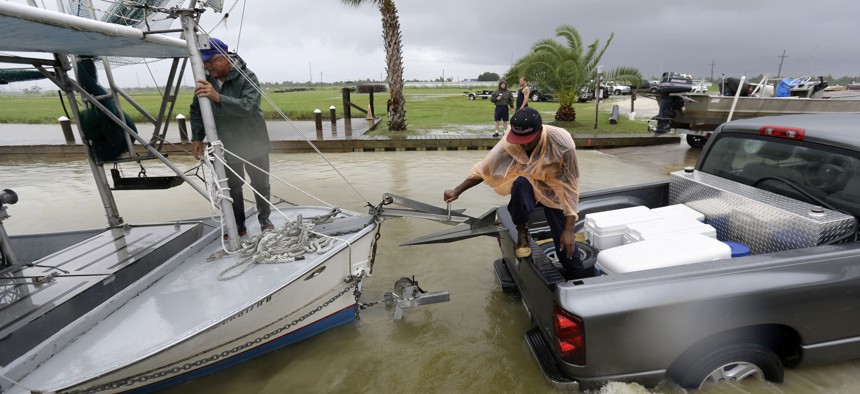Confronting the Costs of Coastal Land Loss

Tony Danos, left, and C.J. Johnson pull a shrimp boat out of the water, in anticipation of Tropical Storm Karen, at Myrtle Grove Marina in Plaquemines Parish, La., Friday, Oct. 4, 2013. AP Photo

Connecting state and local government leaders
2018 NAVIGATOR AWARD WINNER: Mathew Sanders, Resilience Program and Policy Administrator, Office of Community Development, Disaster Recovery Unit, State of Louisiana
This is the second in a series of 10 profiles on the individuals and teams who were named 2018 Route Fifty Navigator Award winners, starting with The Leaders category.
The Louisiana coast is disappearing, acres of land eroding away every day. It’s a well known fact, which for years has prompted commissions, studies and development of new infrastructure to rechannel Mississippi River sediment back into the wetlands where it is needed.
The state’s goal through its 50-year, $50 billion coastal master plan is to stop the losses as much as possible, even rebuilding land where they can. But the most recent version of the plan acknowledges that land will be lost even with these efforts.
“As we can reasonably anticipate over a 50-year timespan, even if we assume the complete build out of the coastal master plan, we are likely to lose more land than today and we are likely to incur more coastal surge risk,” said Mathew Sanders with Louisiana’s Office of Community Development.
Faced with this reality, Sanders has led a team embarked on a related mission: talking to people in six coastal parishes that have experienced flooding about what they want to see happen in their communities.
The project was paid for as part of a $92 million federal grant, which is also being used to move the Native American community on Isle de Jean Charles away from their eroding strip of land along the Gulf of Mexico to property further inland.
The separate Louisiana Strategic Adaptations for Future Environments program got started in 2017 with the task of asking people along the coast to think about how they want to see their communities prepare for the growing flood risk. LA SAFE also will allocate $40 million for 10 specific demonstration projects that participants helped developed.
With the help of the Foundation for Louisiana, the state’s team held 71 community meetings with different sized groups—eventually including more than 2,800 participants—to lay out information about expected land loss and future flood risk, as well as get their input on what that should mean going forward.
“People understand the risk that we live under,” Sanders said. “They also understand there is some inherent opportunity.”
Sanders noted that people want to preserve much of what they love about living on the coast, such as their connections to the water and the land. But they also are looking for services like ready access to health care and amenities like a local coffee shop that sometimes are no longer available where they live.
“We talk about this rich cultural tapestry in the state of Louisiana, much of which is sourced from the coast,” he said. “How do we maintain that while also understanding and embracing this transition that is gradually taking place and will continue to take place in time?”
Earlier this year, Gov. John Bel Edwards announced the 10 initial projects born out of the effort, such as mental health treatment in a parish that has been hit hard by storms. Another wants to build a “resilient housing prototype,” which would be sold at both market rates and to lower income residents. Other ideas: stormwater management, home buyouts, and creation of a “safe harbor” for fishing vessels.
The state is now moving forward on finalizing parish-focused development plans, as well as a regional outlook that tries to provide a “strategic assessment” of the challenges over the next 50 years. The plans will look at “how and where we should build,” Sanders said, along with “what should the general attributes be as we think about future development activity.”
Laura Maggi is the Managing Editor of the Government Executive's Route Fifty and is based in Washington, D.C.

NEXT STORY: A Collaborative Effort to Eliminate Return Visits to the Hospital





